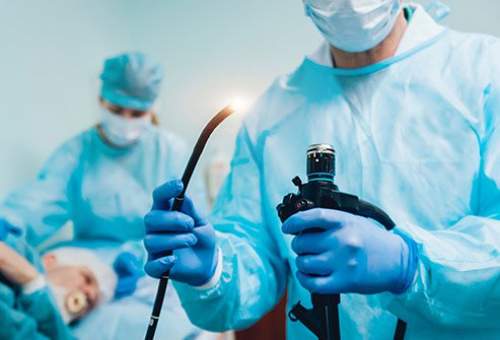Endoscopy is a medical technique used to look inside the body to diagnose or detect anomalies. The technique is a very important process that has been widely praised in medical spaces.
With many diseases being discovered in the internal parts of the body in recent times, the importance of endoscopy has been appreciated even more. Apart from the fact that the procedure helps discover potential issues in the body, it also accurately diagnoses anomalies in the human body.

In this post, we will take a look at a general overview of the endoscopy process, and more importantly, we will consider how much the procedure costs in Kenya today.
Cost of Endoscopy in Kenya
There are different types of endoscopy, and they vary in price. The upper and lower endoscopy are the two main types available today, and they depend on the site in the body the technique is to be carried out.
As it stands, the upper GI endoscopy is the most common in Africa and also the cheapest.
Usually, the procedure costs between KES 35,000 – KES 62,000 depending on the clinic or hospital you are looking to undergo the process. Lower endoscopy is gradually becoming more common in Kenya today and in most medical centers. It costs between KES 44, 000 and KES 73, 000 . It should be noted that some factors, including the location of the hospital, and other similar factors affect how much the process goes for. For instance, endoscopy is usually more expensive in private hospitals, compared to government-owned centers.
Furthermore, the city you’re doing Endoscopy is also a major determinant on the cost. The cost is cheaper in some cities compare to others. The following is the average price of full Endoscopy according to cities:
- Nairobi == from KES 90,000
- Mombasa ==from KES 90,000
- Kisumu == from KES 110,000
- Nauru == from KES 110,000
- Ruiru == from KES 150,000
LAST UPDATED: August 20, 2022
Endoscopy – What You Should Understand About the Procedure
Endoscopy is a non-surgical procedure used to scan a person’s gastric tract. The procedure generally involves a springy tube that has light and camera carefully attached, slotted into the patient. The camera allows the doctor to view pictures of the patient’s digestive tract on a TV monitor. During the process of upper endoscopy, which is the most common technique, an endoscope is passed through the mouth through the throat and into the esophagus, which allows the doctor to see through the esophagus and upper parts of the intestine. In some instances, the endoscope can be passed into the colon through the rectum to study the area of the intestine.
There is another class of endoscopy called Endoscopic Retrograde Cholangiopancreatography. This is also called the ERCP. This type of endoscopy allows doctors to see through the pancreas, gallbladder, and other similar structures inside the body. This process is also used for stent placement. Another related process is Endoscopic ultrasound (EUS). This process combines upper endoscopy and ultrasound analysis to obtain imageries and info about various parts of the digestive systems.
The endoscopy procedure does not take a long time. The procedure is expected to be completed between 10 – 30 minutes. However, it could be extended to 45 minutes, depending on the type of endoscopy. The recovery time after the procedure takes extra 30 minutes to 1 hour. During the recovery period, the patient is required to sit or lay down and rest.
There are alternative procedures doctors recommend if the patients are not okay with endoscopy or they have underlying reasons why they cannot undergo the process. Some of the alternative procedures include barium x-ray and sonogram, which helps study organs in the upper side of the abdomen.
How To Prepare for Endoscopy
There are several precautions and steps to be taken when preparing for the endoscopy procedure. The first, and perhaps, the most important, is gut preparation. Inspecting the upper digestive tract requires fasting for between 6 to 8 hours before the procedure. To observe the colon, it is required it is clear of stool. Therefore, a laxative or group of laxatives will be given to the patient a day or many hours before the procedure.
The patient should also understand that they will most likely be sedated. For most check-ups with an endoscope, a sedative is usually provided. This increases the ease of the patent undergoing the examination. The sedative is usually administered either via an injection into the vein or drugs and produces relaxation and light sleep. While the patients usually wake up within an hour after the procedure, the sedative usually lasts for quite a while and the patient might still be feeling it the following day. General anesthesia is given on very special occasions and might make the patient sleep for a prolonged period.
When Patients Require Endoscopy
Endoscopy is a very useful technique in the medical space. The procedure is recommended for various reasons and helps diverse diagnoses. Generally, doctors recommend endoscopy when they notice internal anomalies like ulcers, constant stomach ache, digestive tract bleeding, chronic constipation, gastritis, and other similar issues. Also, there is a high chance medical practitioners recommend endoscopy when the patient has difficulty swallowing or they notice a growth in the colon.
Although the already highlighted conditions are common reasons why endoscopy is usually recommended, the procedure has also helped in the removal of tissues, which is called a biopsy, to further inspect anomalies in the body. Endoscopy is also used to treat a gastric tract problem. For instance, the process might not only discover active bleeding from an ulcer, but devices can also be passed through the endoscope to help stop the bleeding. Also, gallstones that have passed outside the gallbladder and into the bile duct can often be removed with the use of ERCP.
Related Stuff
[catlist categorypage=yes]